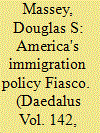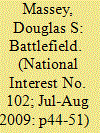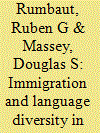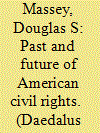| Srl | Item |
| 1 |
ID:
125136


|
|
|
|
|
| Publication |
2013.
|
| Summary/Abstract |
In this essay I discuss how and why U.S. policies intended to stop Latin American immigration to the United States not only failed, but proved counterproductive by ultimately accelerating the rate of both documented and undocumented migration from Mexico and Central America to the United States. As a result, the Latino population grew much faster than demographers had originally projected and the undocumented population grew to an unprecedented size. Mass illegality is now the greatest barrier to the successful integration of Latinos, and a pathway to legalization represents a critical policy challenge. If U.S. policy-makers wish to avoid the failures of the past, they must shift from a goal of immigration suppression to one of immigration management within an increasingly integrated North American market.
|
|
|
|
|
|
|
|
|
|
|
|
|
|
|
|
| 2 |
ID:
090195


|
|
|
|
|
| Publication |
2009.
|
| Summary/Abstract |
The only problem with the invasion is that it never happened. The U.S.-Mexico border is not now and has never been out of control. From 1950 to the present, the total number of migrants entering the United States from Mexico has varied very little. There has certainly been no massive upsurge. What changed were the auspices under which Mexicans entered the country, their place of entry, their ultimate U.S. destination and their tendency to remain here rather than return home. Workers previously labeled immigrants became illegals. The border was fortified. States with high immigrant populations cracked down. Walls were built. Immigration turned into a militarized policy issue. And since it became increasingly risky for Mexicans to cross the border, once here, they remained. All these changes are a consequence of our own misguided immigration and border policies.
|
|
|
|
|
|
|
|
|
|
|
|
|
|
|
|
| 3 |
ID:
125148


|
|
|
|
|
| Publication |
2013.
|
| Summary/Abstract |
While the United States historically has been a polyglot nation characterized by great linguistic diversity, it has also been a zone of language extinction in which immigrant tongues fade and are replaced by monolingual English within a few generations. In 1910, 10 million people reported a mother tongue other than English, notably German, Italian, Yiddish, and Polish. The subsequent end of mass immigration from Europe led to a waning of language diversity and the most linguistically homogenous era in American history. But the revival of immigration after 1970 propelled the United States back toward its historical norm. By 2010, 60 million people (a fifth of the population) spoke a non-English language, especially Spanish. In this essay, we assess the effect of new waves of immigration on language diversity in the United States, map its evolution demographically and geographically, and consider what linguistic patterns are likely to persist and prevail in the twenty-first century.
|
|
|
|
|
|
|
|
|
|
|
|
|
|
|
|
| 4 |
ID:
104549


|
|
|
|
|
| Publication |
2011.
|
| Summary/Abstract |
Although American society will not become race-blind anytime soon, the meaning of race is changing, and processes of racial formation now are quite different than those prevailing just two generations ago. Massey puts the present moment in historical perspective by reviewing progress toward racial equality through successive historical epochs, from the colonial era to the age of Obama. He ends by exploring the contours of racial formation in the United States today, outlining a program for a new civil rights movement in the twenty-first century.
|
|
|
|
|
|
|
|
|
|
|
|
|
|
|
|